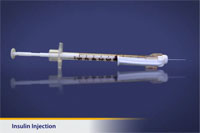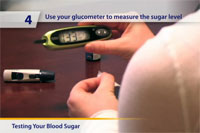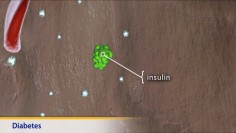
Diabetes: Type 2
What is type 2 diabetes?
Type 2 diabetes is a disorder that happens when your body does not make enough insulin or is unable to use its own insulin properly. The inability to use insulin is called insulin resistance. These problems with insulin cause the level of sugar in your blood to get too high.
When you digest food, your body breaks down much of the food into sugar (glucose). Your blood carries the sugar to your cells for energy. Insulin made by the pancreas gland moves the sugar from the bloodstream into the cells.
When your body does not have enough insulin or cannot use insulin properly, sugar cannot get into your cells. Sugar then builds up in the blood. Too much sugar in the blood can cause many problems. These problems can be life threatening if they are not treated. However, proper treatment can control your blood-sugar level and prevent or delay the complications of diabetes.
Type 2 diabetes happens mostly in overweight adults over age 40. Overweight children and teens can also have this type of diabetes. As more people become overweight, more people, including children and teens, are becoming diabetic.
Many millions of people in the US have diabetes. Most of them have type 2 diabetes. Although type 2 diabetes occurs in all races, it occurs most often among Native Americans, Hispanics, African Americans, and Asian Americans.
How does it occur?
The exact cause of type 2 diabetes is not known. Age, weight, lack of exercise, and a high-calorie diet appear to be important factors. As people get older or overweight, they are more likely to have diabetes. Their cells become unable to use the insulin made by the pancreas.
If one or both of your parents have had type 2 diabetes, your chance of having type 2 diabetes is much higher.
What are the symptoms?
Type 2 diabetes may cause the following symptoms:
- increased urination
- increased thirst
- blurry vision
- unexpected weight gain or weight loss
- frequent infections—for example, of the skin, gums, or bladder
- frequent yeast infections of the vagina
- tiredness
- infections of the foreskin in uncircumcised men.
Most people, however, have no symptoms for months or even years. This is why it is so important to get your blood sugar checked every year or as often as your healthcare provider recommends.
How is it diagnosed?
Your healthcare provider will ask about your medical history and your symptoms and examine you. You will have a blood test to check the level of sugar in your blood. Three blood tests may be done to diagnose diabetes:
- The fasting plasma glucose test (FPG) is easy and fast. A sample of your blood is tested in the morning when you have not eaten anything since the night before. If this test shows you have a fasting blood sugar of 126 milligrams per deciliter (mg/dL), or 7.0 millimoles per liter (mmol/L), or higher, you may have diabetes. You may have a second fasting test on a different morning to confirm the first result. If a second test confirms your high blood sugar, your provider will diagnose type 2 diabetes.
- For the oral glucose tolerance test (OGTT), a sample of your blood is taken when you have not eaten anything since the night before. Then you drink a special sugar drink and your blood is tested again 2 hours later. If after 2 hours your blood sugar level is 200 mg/dL (11.1 mmol/L) or higher, you have diabetes.
- The A1C (hemoglobin A1C) test gives a measurement of your average blood sugar for 3 months. If your A1C is 6.5% or higher, you have diabetes.
How is it treated?
The goal of treatment is to control the level of sugar in your blood. You want to try to keep the sugar level in a normal range. This is done by:
- measuring your blood sugar regularly
- good nutrition and meal planning
- exercise
- medicine, including pills or insulin, if you are not able to control your blood sugar with diet and exercise.
Blood sugar tests
You will learn how to check your blood sugar at home. You will use a small machine called a blood glucose meter or glucometer to use to test your blood sugar. You will need some lancets and test strips. Lancets are little blades or needles used to prick your finger to get drops of blood for the test strips. Your healthcare provider will tell you when and how often you need to check your blood sugar.
When you are first diagnosed with diabetes you will need to check your blood sugar often. When your diabetes is in better control, your provider will tell you how you can decrease your sugar checks.
Keep a log of your blood sugar measurements. Many glucose meters can keep a record of your recent sugar readings for you inside the meter. Your provider will check the log at your appointments to see how well your treatment is working.
The A1C test can show your average blood sugar control over the past 2 or 3 months. Your healthcare provider may do this test every 3 months to check your overall control of your blood sugar. This is the best way to see if you are keeping your diabetes under control. However, you will still need to do daily blood sugar measurements. Daily checks of your blood sugar show whether your daily treatment plan (diet, exercise, and/or medicine) is working throughout the day.
Meal planning
Your healthcare provider or a dietitian will give you guidelines about foods and daily calories. If you are overweight, eating fewer calories and getting more exercise to lose weight will help you lower your blood sugar. Choosing healthy foods for your diet will help you lose weight and improve your health. Sometimes losing just 7 to 10 pounds can reduce or eliminate your need to take medicine for diabetes.
Exercise
Physical activity is important in managing type 2 diabetes. Getting enough exercise is all some people need to control their blood sugar. Exercise improves blood flow, uses up more of the sugar in your blood, and helps your body use insulin better. Walking is one of the best exercises you can do. Ask your healthcare provider for exercise recommendations.
Medicine
If you cannot control your blood sugar with diet and exercise, your healthcare provider will prescribe medicine to lower it. You may need more than 1 type of medicine to keep your blood sugar in a normal range.
Common medicines taken by mouth to lower blood sugar when you have type 2 diabetes are:
- Metformin (Glucophage), which helps the body use insulin better. This medicine is taken 2 to 3 times a day. It may be combined with another medicine.
- Sulfonylureas, which help your pancreas release more insulin. Examples of this type of medicine are glyburide (DiaBeta, Glynase), glipizide (Glucotrol), and glimepiride (Amaryl). These medicines are taken 1 to 3 times a day.
- Repaglinide (Prandin) and nateglinide (Starlix), which also help release more insulin. They are taken before meals.
- Rosiglitazone (Avandia) and pioglitazone (Actos), which help the body use insulin better. They are taken once a day. They may be combined with sulfonylureas, metformin, or insulin. You will need to have blood tests to check the effect of these medicines on your liver.
- Acarbose (Precose) and miglitol (Glyset), which slow absorption of sugars from the digestive system.
Insulin is used when diet, exercise, and oral medicines are not keeping your blood sugar levels normal. Insulin is available in different forms. It may be short, intermediate, long, or fast acting. It is usually given as a shot. If you need insulin, your provider will teach you how to give shots to yourself. You may need a shot 1 to 4 times a day.
Two new medicines named Symlin and Byetta are now available to help people with type 2 diabetes. They may be prescribed if you are having trouble controlling your blood sugar. Both are given as shots. They help control your blood sugar by slowing the passage of food through the stomach. Ask your healthcare provider about them.
When you are using any type of diabetic medicine, you must carefully follow your provider's directions for checking your blood sugar. This will not only help you have good blood sugar control, but it will help keep you from having blood sugar that is too low. Blood sugar that is too low can be life-threatening.
How long will the effects last?
Taking good care of yourself to avoid complications is especially important with diabetes. Diabetes can cause some serious problems, such as heart disease, stroke, blindness, kidney failure, and nerve damage, especially to your feet and legs. Carefully controlling your blood sugar and blood pressure will prevent or delay these complications. Good control of diabetes depends on following the diet and exercise plans prescribed by your healthcare provider to keep your blood sugar in the target range. If your diabetes is not controlled by diet and exercise, it is important to follow the medication plan recommended by your healthcare provider.
How can I take care of myself?
Follow your diet plan.
- Buy only foods in your diet plan.
- Eat on a regular schedule.
- Eat slowly and chew food thoroughly.
- Drink water or other calorie-free drinks when you feel the urge to eat between meals.
- Limit the amount of alcohol you drink. Alcohol can cause low blood sugar. It can also worsen nervous system problems caused by diabetes.
- Learn how to make healthy choices when you eat out.
- Ask for diabetic meals when you travel, for instance, at hotels or on airplanes.
Follow your healthcare provider's advice for physical activity.
- Choose activities you like.
- Exercise with friends.
Don’t smoke. Smoking speeds up the damage to the heart and blood vessels.
Carefully follow the instructions your healthcare provider has given you for taking prescribed medicine.
Other things you can do are:
- Keep your follow-up appointments with your healthcare provider.
- Keep your blood pressure in the recommended range.
- Keep your blood lipids (cholesterol, HDL, LDL, and triglycerides) in the recommended ranges.
- Learn how to care for your feet every day.
- Have an eye exam by an eye doctor soon after you are diagnosed and every year after that. If you have eye problems from diabetes, you may need more frequent exams.
- Also make sure your kidneys are checked at least once every year.
- Ask your provider if you should take a daily low dose of aspirin.
- Always carry an ID that says you have diabetes, in case of an emergency.
Learn about diabetes and its complications so you can make the correct decisions to control your blood-sugar levels. Many hospitals have diabetes educators and dietitians who can help you. Ask your healthcare provider to refer you to these people.
You can get pamphlets and information about diabetes, including diabetic cookbooks, from:
The American Diabetes Association
Phone: 800-DIABETES (800-342-2383)
Web site: http://www.diabetes.org
How can I help prevent type 2 diabetes?
Even if there is a history of diabetes in your family, you may be able to avoid having the disease if you:
- Keep a healthy weight.
- Exercise regularly according to your healthcare provider's recommendations.
- Eat a healthy diet that includes fruits, vegetables, lean protein, and high-fiber grains. Limit sugars, white rice, and foods made with white flour. Choose whole grain and whole wheat breads and cereals instead.
If you have a family history of diabetes, you should get your blood sugar checked every year.
Last modified: 2011-08-15
Last reviewed: 2011-03-03



